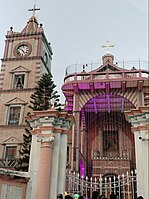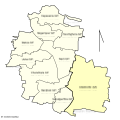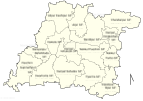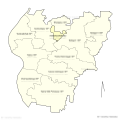Hooghly district
Hooghly
হুগলি | |
|---|---|
|
Clockwise from top-left: Durga temple of Khanakul | |
| Area | |
• Total | 3,149 km2 (1,216 sq mi) |
| Population (2011) | |
• Total | 5,519,145 |
| • Density | 1,800/km2 (4,500/sq mi) |
| Demographics | |
| • Literacy | 82.55 per cent |
| • Sex ratio | 961 ♂/♀ |
| Languages | |
| • Official | Bengali[1][2] |
| • Additional official | English[1] |
| Time zone | UTC+05:30 (IST) |
| Website | hooghly |
Hooghly district (
History
The district of Hooghly derived its name from the town of Hooghly on the west bank of the
The district has thousands of years of rich heritage as part of the Bengali kingdom of
Within a few decades, the town of Hooghly turned into a major commercial centre and the largest port in Bengal. In 1579–80, Mughal Emperor Akbar gave permission to a Portuguese captain Pedro Tavares to establish a city anywhere in the Bengal province. They chose Hooghly, and it became the first European settlement in Bengal. In 1599, the Portuguese traders built a convent and a church in Bandel. This was the first Christian church in Bengal and is known as ‘Bandel Church’ today.
The Portuguese traders started slave trading, robbery and converting natives into Christians by pressure. At one point they stopped paying taxes to the Mughal Empire. As a result, Emperor Shah Jahan ordered the then-ruler of Bengal province, Qasim Khan Juvayni, to blockade the city of Hooghly. This led to a war in 1632 in which the Portuguese were defeated.
Among other European powers that came to Hooghly were the Dutch, the Danish, the British, the French, the Belgians and the Germans. Dutch traders centred their activities in the town Chuchura which is south of Hooghly. Chandannagar became the base of the French and the city remained under their control from 1816 to 1950. Similarly, the Danish establishment in settlement in Serampore (1755). All these towns are on the west bank of the Hooghly River and served as ports. Among these European countries, the British ultimately became most powerful.

Initially the British were based in and around the city of Hooghly like traders from other countries. In 1690
After the Battle of Buxar this region was brought under direct British rule until India's independence in 1947. After independence, this district merged into the state of West Bengal.
Though the city of Hooghly is more than 500 years old, the district of Hooghly was formed in 1795 with the city of Hooghly as its headquarters. Later the headquarters shifted to the town of

Tarakeswar Temple
The
Pilgrims visit the temple throughout the year, especially on Mondays. Thousands of pilgrims visit Tarakeswar on the occasions of
Geography

The district is flat, with no place having an elevation of more than 200 meters.[
Economy
Hooghly is one of the most economically developed districts in West Bengal. It is the main
There are a number of industrial complexes including one of the largest car manufacturing plants in India, the Hindustan Motors plant in Uttarpara.
It was also home to the Singur Tata Nano controversy. Hindustan Motors plant was closed in 2014. Bandel Thermal power plant and Tribeni tissue plant (ITC) are running smoothly.
Divisions
Administrative subdivisions

The district comprises four subdivisions: Chinsurah, Chandannagore, Srirampore and Arambagh.
- Chinsurah subdivision consists of two municipalities (Hugli-Chuchura and Bansberia) and five community development blocs: Balagarh, Chinsurah–Mogra, Dhaniakhali, Pandua and Polba–Dadpur.
- Chandannagore subdivision consists of Chandannagar municipal corporation and three municipalities (Bhadreswar, Champdani and Tarakeswar) and three community development blocs: Haripal, Singur and Tarakeswar.
- ) and four community development blocks: Chanditala–I, Chanditala–II, Jangipara and Sreerampur Uttarpara.
- Arambag municipality and six community development blocks: Arambag, Khanakul–I, Khanakul–II, Goghat–I, Goghat–II and Pursurah.[3]
Hugli-Chuchura is the district headquarters. There are 23 police stations, 18 development blocks, 12 municipalities and 207 gram panchayats in this district.[3][4]
Other than municipality area, each subdivision contains community development blocks that are divided into rural areas and census towns. There are 41 urban units: 12 municipalities and 64 census towns.[4][5]
Chinsurah subdivision
- Two municipalities: Hugli-Chinsurah and Bansberia
- Balagarh community development block consists of rural areas with 13 gram panchayats and four census towns: Jirat, Sripur, Badhagachhi, Mirdhanga.
- Chinsurah Mogra community development block consists of rural areas with 10 gram panchayats and eight census towns: Kodalia, Raghunathpur, Madhusudanpur, Amodghata, Shankhanagar, Chak Bansberia, Kulihanda, Simla.
- Dhaniakhali community development block consists of rural areas only with 18 gram panchayats.
- Pandua community development block consists of rural areas with 15 gram panchayats and three census towns: Boinchi, Pandua and Batika.
- Polba Dadpur community development block consists of rural areas only with 12 gram panchayats.
Chandannagore subdivision
- Chandannagar municipal corporation
- Three municipalities: Bhadreswar, Champdani, and Tarakeswar
- Haripal community development block consists of rural areas only with 15 gram panchayats one census town: Bargachhia.
- Singur community development block consists of rural areas with 16 gram panchayats and one census town: Singur.
- Tarakeswar community development block consists of rural areas only with 10 gram panchayats.
Srirampore subdivision
- Six municipalities:
- Chanditala I community development block consists of rural areas only with 9 gram panchayats and 2 census towns: Masat, Gangadharpur, Aniya, Bhagabatipur, Haripur, Krishnarampur, Kumirmorah, Nawabpur, Sheakhala.
- Krishnapur and Mrigala.
- Jangipara community development block consists of rural areas only with 10 gram panchayats.
- Nabagram and Kanaipur.
Arambagh subdivision
- One municipality: Arambag.
- Arambag community development block consists of rural areas only with 15 gram panchayats.
- Khanakul I community development block consists of rural areas only with 13 gram panchayats.
- Khanakul II community development block consists of rural areas only with 11 gram panchayats.
- Goghat I community development block consists of rural areas only with 8 gram panchayats.
- Goghat II community development block consists of rural areas only with 9 gram panchayats.
- Pursurah community development block consists of rural areas only with 8 gram panchayats.
Blocks map
-
Arambag CD block map showing GP and urban areas
-
Balagarh CD block showing GP areas
-
Chanditala-I CD block map showing GP areas
-
Chanditala-II CD block map showing GP and urban areas
-
Chinsurah-Mogra CD block map showing GP and urban areas
-
Dhaniakhali CD block showing GP areas
-
Goghat-I CD block map showing GP areas
-
Goghat-II CD block showing GP areas
-
Haripal CD block map showing GP areas
-
Jangipara CD block map showing GP areas
-
Khanakul-I CD block map showings GP areas
-
Khanakul-II CD block Map showing GP areas
-
Pursurah CD block map showing GP areas
-
Pandua CD block map showing GP areas
-
Polba-Dadpur CD block map showing GP areas
-
Singur CD block map showing GP and urban areas
-
Seerampur-Uttarpara CD block map showing GP and urban areas
-
Tarokeswr CD block map showing GP and urban areas
Assembly constituencies
The district is divided into 18
- Jangipara(assembly constituency no. 177),
- Chanditala(assembly constituency no. 178),
- Uttarpara(assembly constituency no. 179),
- Serampore(assembly constituency no. 180),
- Champdani(assembly constituency no. 181),
- Chandernagore(assembly constituency no. 189),
- Singur(assembly constituency no. 183),
- Haripal(assembly constituency no. 184),
- Tarakeswar(assembly constituency no. 185),
- Chinsurah(assembly constituency no. 186),
- Saptagram (assembly constituency no. 187),
- Balagarh (SC)(assembly constituency no. 188),
- Pandua(assembly constituency no. 189),
- Dhaniakhali (SC)(assembly constituency no. 191),
- Pursurah(assembly constituency no. 192),
- Khanakul(assembly constituency no. 202),
- Arambagh(assembly constituency no. 194) and
- Goghat (SC)(assembly constituency no. 195).
12 Balagarh, Dhaniakhali, Khanakul and Goghat constituencies are reserved for
Tarakeswar, Pursurah, Khankul, Arambag and Goghat constituencies are part of the
As per order of the
| No. | Constituency | Lok Sabha constituency | MLA | Party | |
|---|---|---|---|---|---|
| 185 | Uttarpara | Srerampur
|
Kanchan Mullick | All India Trinamool Congress
| |
| 186 | Sreerampur
|
Sudipto Roy | All India Trinamool Congress
| ||
| 187 | Champdani | Arindam Guin | All India Trinamool Congress
| ||
| 188 | Singur | Hooghly | Becharam Manna | All India Trinamool Congress
| |
| 189 | Chandannagar | Indranil Sen | All India Trinamool Congress
| ||
| 190 | Chunchura | Asit Mazumdar | All India Trinamool Congress
| ||
| 191 | Balagarh (SC) | Manoranjan Byapari | All India Trinamool Congress
| ||
| 192 | Pandua | Ratna De | All India Trinamool Congress
| ||
| 193 | Saptagram | Tapan Dasgupta | All India Trinamool Congress
| ||
| 194 | Chanditala | Srerampur
|
Swati Khandoker | All India Trinamool Congress
| |
| 195 | Jangipara | Snehasis Chakraborty | All India Trinamool Congress
| ||
| 196 | Haripal | Arambagh | Karabi Manna | All India Trinamool Congress
| |
| 197 | Dhanekhali (SC) | Hooghly | Ashima Patra | All India Trinamool Congress
| |
| 198 | Tarakeswar | Arambagh | Ramendu Sinharay | All India Trinamool Congress
| |
| 199 | Pursurah | Biman Ghosh
|
Bharatiya Janata Party | ||
| 200 | Arambagh (SC)
|
Madhusudan Bag | Bharatiya Janata Party | ||
| 201 | Goghat (SC) | Biswanath Karak | Bharatiya Janata Party | ||
| 202 | Khanakul | Susanta Ghosh | Bharatiya Janata Party | ||
Balagarh, Dhanekhali, Arambag and Goghat constituencies will be reserved for
Police administration
Hooghly District comes under Burdwan Police Range. Hooghly Rural Police District was created on 30 June 2017, curbing out of erstwhile Hooghly district. Presently it consists of sixteen police station with jurisdiction, one women police station and one Cyber Police Station. The head quarter of Hooghly Rural Police District was shifted to Kamarkundu under Singur PS from Chinsura. Chandannagar Police Commissionerate was formed after bifurcation of the Hooghly Police District, and has nine police stations under its jurisdiction established on 30 June 2017, is a police force with primary responsibilities in law enforcement and investigation within certain urban parts of Hooghly district. The Commissionerate is part of the West Bengal Police, and comes under the Department of Home & Hill Affairs, Government of West Bengal.
For the functioning of 23 police stations of the district, District Intelligence Branch, District Enforcement Branch and District Reserve Police Force SP, Hooghly is assisted by three additional superintendents:
- HQ: Having his office at Chinsurah, he looks after the Sadar Sub-Division and District Police Force, being assisted by Dy.S.P. (HQ) and Dy.S.P. (D&T).
- Industrial: He is in Serampore. He is the supervising officer for Serampore and Chandernagore Sub Divisions, assisted by SDPO: Serampore and SDPO: Chandernagore.
- Rural: He is in Arambagh and is the supervising officer for Arambagh Sub Division; being assisted by SDPO: Arambagh.
Transport
Rail
The railway communication of the district, especially at the suburban area, are available throughout the district.
There are four junction stations in Hooghly:
- Bandel Junction railway station
- Dankuni Junction railway station
- Sheoraphuli railway station
- Kamarkundu
The railway is under Howrah Division. The Howrah – New Delhi Rajdhani Route passes through the district
Bus
There are several bus stands in Hooghly district. Grand Trunk Road passes through the district and Private and Govt. buses are available.
Demographics
| Year | Pop. | ±% p.a. |
|---|---|---|
| 1901 | 1,076,416 | — |
| 1911 | 1,115,927 | +0.36% |
| 1921 | 1,105,907 | −0.09% |
| 1931 | 1,141,558 | +0.32% |
| 1941 | 1,415,934 | +2.18% |
| 1951 | 1,605,004 | +1.26% |
| 1961 | 2,231,288 | +3.35% |
| 1971 | 2,872,116 | +2.56% |
| 1981 | 3,557,306 | +2.16% |
| 1991 | 4,355,230 | +2.04% |
| 2001 | 5,041,976 | +1.47% |
| 2011 | 5,519,145 | +0.91% |
| source:[8] | ||
According to the
Religion
| Religion | Population (1941)[13]: 75 | Percentage (1941) | Population (2011)[12] | Percentage (2011) |
|---|---|---|---|---|
| Hinduism |
799,688 | 62.82% | 4,574,569 | 82.89% |
| Islam |
207,077 | 35.03% | 870,204 | 15.77% |
| Tribal religion[a] | 69,500 | 2.04% | 49,050 | 0.89% |
| Others[b] | 1,464 | 0.11% | 25,322 | 0.45% |
| Total Population | 1,177,729 | 100% | 5,519,145 | 100% |
Hindus are the majority community in the district. Muslims are the largest minority, concentrated more in rural areas.
Language
At the time of the 2011 census, 87.49% of the population spoke Bengali, 7.59% Hindi, 2.37% Santali and 1.72% Urdu as their first language. Hindi and Urdu speakers are predominantly found in urban areas.[14]
Education

There are 2992 primary schools, 408 high schools, 127 higher secondary schools, 22 colleges, and 6 technical institutes in Hooghly district. The most notable institutions among them are:
- Hooghly Collegiate School established in 1812
- Hooghly Madrasah established in 1817[15]
- Furfura Fatehia Senior Madrasah established in 1902
- Hooghly Mohsin College established in 1836
- Government College of Engineering & Textile Technology Serampore
- Sarat Centenary College
- Vivekananda Mahavidyalaya, Haripal
- Mahesh Sri Ramkrishna Ashram Vidyalaya (Higher Secondary)
- Saroj Mohan Institute of Technology
- Serampore College
- Serampore Girls' College
- Serampore Union Institution
- Akna Girl's High School
- Chatra Nandalal Institution
- Mahesh High School
- Hooghly Branch (Govt) School
- St Joseph's Convent, Chandannagar
- Balagarh Bijoy Krishna Mahavidyalaya
- Rani Rashmoni Green University established in 2020
- Sitapur Endowment Senior Madrasah
- Badanganj High School
- Pearl Rosary School, established in 2005
Historical places

- Tarakeswar, home of Taraknath Temple.[when?]
- Serampore, where the Senate of Serampore College (University) was established
- Bandel Church, West Bengal's oldest church
- Furfura Sharif, Shrine of Pir Mohammad Abu Bakr Siddique
Notable people
This is a list of notable people from Hooghly District:
- Sridhara was an Indian mathematician, Sanskrit pandit and philosopher. Sridharacharya's formula is also known as the Quadratic formula or Sridharacharya's method.
- Panchanan Karmakar, inventor of wooden Bengali alphabet typeface
- Anil Chatterjee is an actor.
- Brajendra Nath Seal was a humanist philosopher.
- Nawab Siraj au Daulla.
- Raja Ram Mohan Roy, born in Radhanagore. He is considered as the "Father of the Indian Renaissance". He was one of the founders of the Brahmo Sabha, the precursor of the Brahmo Samaj, a socio-religious (Hindu) reform movement in Undivided India.
- Nibaran Chandra Mukherjee was a Brahmo reformer.
- Haji Muhammad Mohsinwas a famous philanthropist.
- Satish Chandra Mukherjee, born in Banipur, was a pioneer in establishing a system of national education in India.
- Subroto Mukherjeewas the first Indian Commander-in-Chief of the Indian Air Force.
- Ganga Prasad Mukherjeewas a physician.
- Jagannath Tarka Panchanan was a legendary Sanskrit scholar and pundit of ancient Hindu Laws.
- Ramakrishna was a Hindu mystic, saint, and religious leader in 19th century Bengal.
- Nagendranath Basu was an archaeologist, encyclopaedist and a nationalist social historian of Bengal.
- Amiya Chakravarty was a literary critic, academic, and Bengali poet. He was a close associate of Rabindranath Tagore, and edited several books of his poetry.
- Ganapati Chakraborty was a magician known for his mesmerizing tricks and is considered to be the pioneer of modern magic in Bengal.
- Rangalal Bandyopadhyay was a Bengali poet, journalist and author.
- Kali Mirza was an 18th-century composer of tappā music in Bengal. A contemporary of Nidhu Babu, he composed over 400 tappās.
- Swami Satyananda Giri.
- Nagendranath Chattopadhyay was a noted Sanskrit scholar and grammarian.
- Murari Mohan Mukherjee was a plastic surgeon.
- Krishna Chandra Bhattacharya was a philosopher at the University of Calcutta known for his method of "constructive interpretation" through which relations and problematics of ancient Indian philosophical systems are drawn out and developed so that they can be studied like problems of modern philosophy.
- Sisir Kumar Mitra was a physicist.
- Madhusudan Gupta was a translator and Ayurvedic practitioner who was also trained in Western medicine and is credited with having performed India's first human dissection at Calcutta Medical College (CMC) in 1836, almost 3,000 years after Susruta.
- Prabhat Kumar Mukhopadhyay was a Bengali author.
- Sarat Chandra Chattopadhyay was a Bengali novelist and short story writer of the early 20th century.
- Akshay Chandra Sarkar was a poet, an editor and a literary critic of Bengali literature.
- Raja Digambar Mitrawas one of the leading Derozians and first Bengali Sheriff of Kolkata.
- Kanailal Dutta was a revolutionary in India's freedom struggle belonging to the Jugantar group.
- Ashapurna Devi was a prominent Indian novelist and poet in Bengali language.
- Brahmabandhav Upadhyay was a theologian, journalist and Indian freedom fighter. He was closely attached with Keshub Chandra Sen, classmate of Swami Vivekananda and close acquaintance of Rabindranath Tagore.
- Ramnidhi Guptawas commonly known as Nidhu Babu . He was one of the great reformers of Bengali tappā music.
- Kirity Roy, a civil rights activist working in West Bengal
- Motilal Roy was a Bengali revolutionary, journalist, social reformer. He founded the "Prabartak Sangha", a nationalist organisation for social works.
- Dwarka Nath Mitra was a famous lawyer and judge of the Calcutta High Court.
- Nabagopal Mitra was an Indian playwright, poet, essayist, patriot and one of the founding fathers of Hindu nationalism. He founded the Hindu Mela, the pioneer institution behind the genesis of Hindu nationalism. Mitra also founded National Press, National Paper, National Society, National School, National Theatre, National Store, National Gymnasium and National Circus, earning him the sobriquet 'National Mitra'.
- Shri Aurobindo.
- Manmohan Ghose was an Indian poet and one of the first from India to write poetry in English. He was a brother of Sri Aurobindo.
- Ashim Kumar Majhi is a politician.
- Nirmal Jibon Ghosh, an Indian revolutionary and member of the Bengal volunteers.
- Premendra Mitra belonged to the renowned Mitra family of Konnagar.
- Surajit Dhara, recipient of the Shanti Swarup Bhatnagar Prize for Science and Technology for his contributions to physical sciences in 2020[16]
- litterateur who coined the term "Hindutva" and has been regarded as a doyen of economic and Indian nationalismin Bengal.
- Abbas Siddiqui, religious scholar.
See also
- Rathayatra of Mahesh, Serampore
Notes
- ^ All tribals were counted under 'Tribal' in the 1941 census irrespective of actual religion practiced.
- ^ Including Jainism, Christianity, Buddhism, Zoroastrianism, Judaism, Ad-Dharmis, or not stated
References
- ^ a b "Fact and Figures". Wb.gov.in. Retrieved 5 July 2019.
- ^ "52nd Report of the Commissioner for Linguistic Minorities in India" (PDF). Nclm.nic.in. Ministry of Minority Affairs. p. 85. Archived from the original (PDF) on 25 May 2017. Retrieved 5 July 2019.
- ^ a b "Directory of District, Sub division, Panchayat Samiti/ Block and Gram Panchayats in West Bengal, March 2008". West Bengal. National Informatics Centre, India. 19 March 2008. Archived from the original on 25 February 2009. Retrieved 4 December 2008.
- ^ a b "Municipal General Election 2005: Hooghly District". Official website of Hooghly district. Retrieved 13 December 2008.
- ^ "Population, Decadal Growth Rate, Density and General Sex Ratio by Residence and Sex, West Bengal/ District/ Sub District, 1991 and 2001". West Bengal. Directorate of census operations. Archived from the original on 19 July 2011. Retrieved 4 December 2008.
- ^ "General election to the Legislative Assembly, 2001–List of Parliamentary and Assembly Constituencies" (PDF). West Bengal. Election Commission of India. Archived from the original (PDF) on 4 May 2006. Retrieved 19 November 2008.
- ^ "Press Note, Delimitation Commission" (PDF). Assembly Constituencies in West Bengal. Delimitation Commission. Retrieved 19 November 2008.
- ^ Decadal Variation In Population Since 1901
- ^ a b c d e f "District Census Handbook: Hooghly" (PDF). censusindia.gov.in. Registrar General and Census Commissioner of India. 2011.
- ^ US Directorate of Intelligence. "Country Comparison:Population". Archived from the original on 13 June 2007. Retrieved 1 October 2011.
Denmark 5,529,888, July 2011 est.
- ^ "2010 Resident Population Data". U. S. Census Bureau. Archived from the original on 19 October 2013. Retrieved 30 September 2011.
Wisconsin 5,686,986
- ^ a b "Table C-01 Population by Religion: West Bengal". censusindia.gov.in. Registrar General and Census Commissioner of India. 2011.
- ^ "CENSUS OF INDIA, 1941 VOLUME VI BENGAL PROVINCE" (PDF). Retrieved 13 August 2022.
- ^ a b "Table C-16 Population by Mother Tongue: West Bengal". www.censusindia.gov.in. Registrar General and Census Commissioner of India.
- ^ TwoCircles.net (12 April 2010). "Two-hundred-year-old Hooghly Madrasa facing closure – TwoCircles.net". Retrieved 1 February 2020.
- ^ "List of recipients" (PDF). Shanti Swarup Bhatnagar Prize for Science & Technology. Government of India. 2020. Retrieved 16 August 2021.























